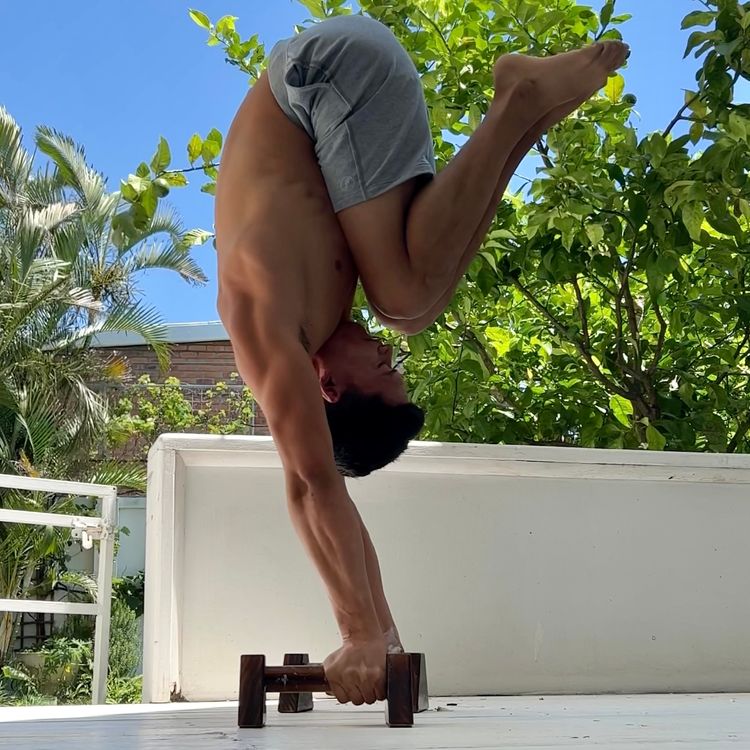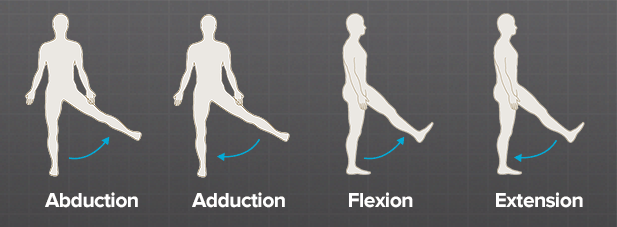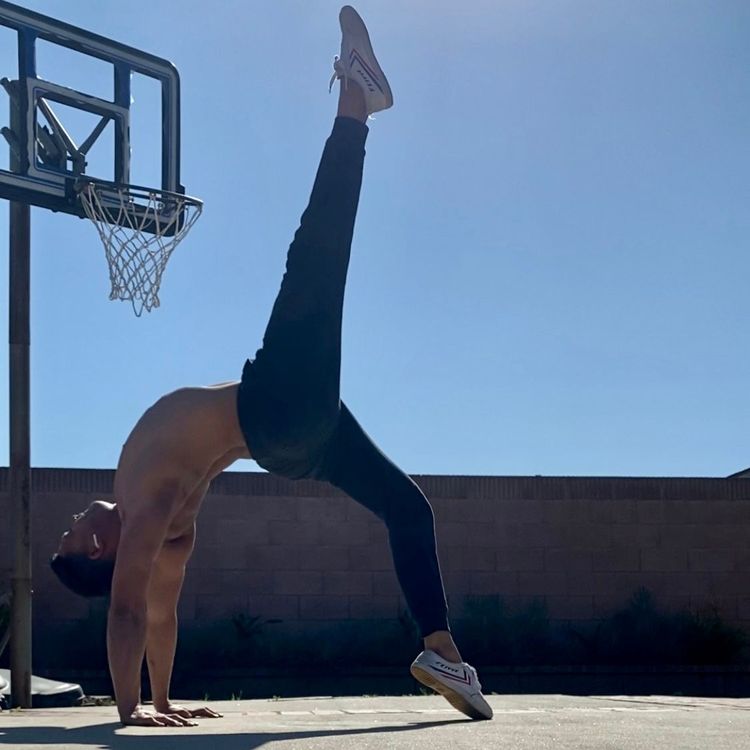How to Combine Flexibility and Strength Training
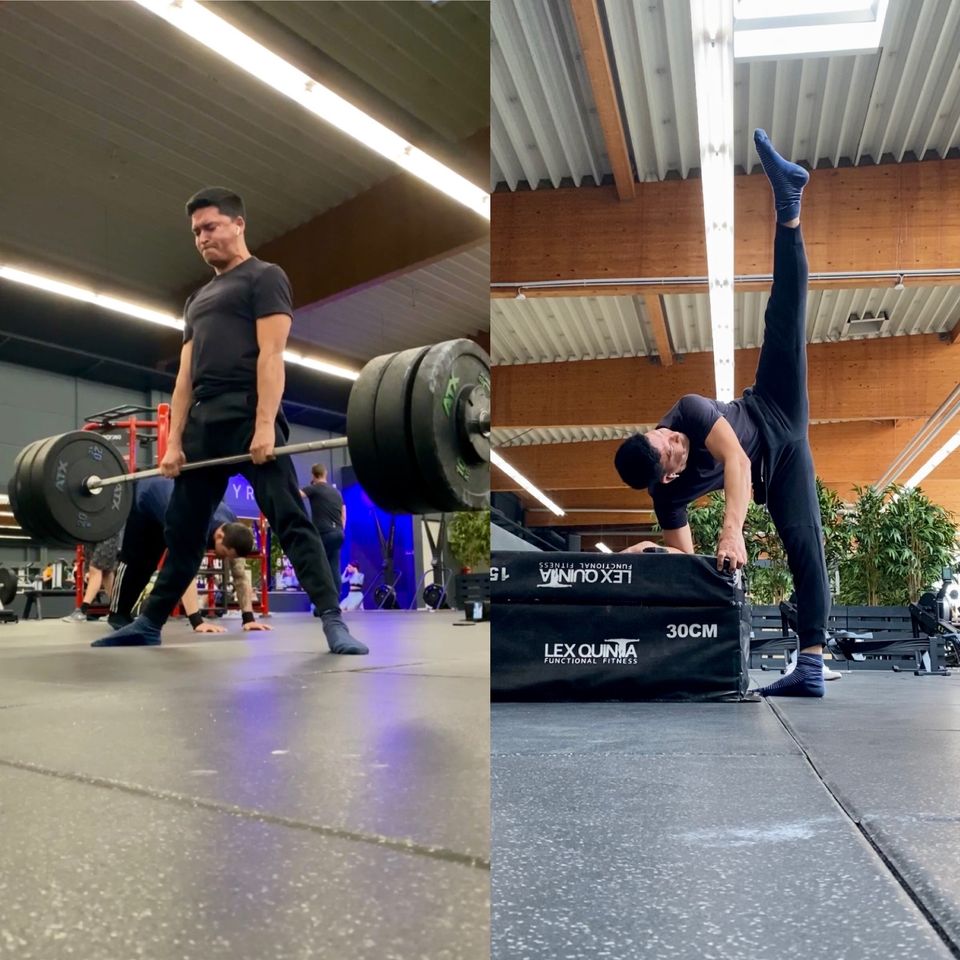
This article aims to provide a guideline on how to combine flexibility training and strength training in the same session.
Since I'm as passionate as it gets about my flexibility training, it's not uncommon for me to end up having conversations about it with pretty much everyone I cross paths with. People from all walks of life. From athletes to engineers to baristas and neighbors. And not to my surprise, what I'm told the most from them is something along the lines of "I reallyyyy need to start stretching". Does this sound familiar? 😅
Aside from the athletes, most of these people are normal everyday people who already spend time in the weight room and are just looking to feel better. And most of them have also tried a few things out. They often share things like "I stretch at the end of my gym sessions" or "I stretch while I'm watching Netflix before bed".
While it's absolutely possible to improve your flexibility by stretching after strength training or while watching your favorite shows, the problem is that most people are typically fatigued, famished, and ready for a nap by this point.
In order to see long-lasting and significant improvements in flexibility, it takes honest, disciplined, and intentional training. The challenge is that a majority of us:
- Don't have time to have standalone flexibility sessions every week.
- Are not willing to cut out entire strength training sessions to work on our flexibility, we've got guns to prepare for the gun show ;)
- Are not necessarily interested in training flexibility for hours at a time.
So what's the solution? We inject flexibility work directly into our strength training sessions without increasing our total training time and without sacrificing our strength gains! It sounds great in theory, but the problem is that there aren't enough guidelines or knowledge on how to do this. My aim here is to provide a few.
But first, let's explain the logic.
Why Combining Flexibility and Strength Training In the Same Session Works
Firstly, we need to look at strength and flexibility through the same lens. They are one and the same. Keep this in mind.
Whether we look at bodybuilders, powerlifters, or Olympic weightlifters, they all have a few things in common. They're all strength training and improving their craft through progressive overload by modifying the same exact same training variables. Training variables such as intensity, volume, range of motion, tempo, rest times, frequency, and so forth. Let's take a deadlift for example. If we wanted to improve our deadlift strength, we could take a classic 5x5 approach, and for a period of time working on incrementally adding weight to the bar each week. This is an example of linear progressive overload by modifying intensity while keeping the other training variables fixed. If the weight lifted increased over the period of time, strength was gained.
Well, the same goes for flexibility training. A proper flexibility program will focus on progressive overload of specific movements and will have a plan in place for modifying the exact same training variables mentioned above. Let's look at the middle splits as an example. One approach for improving adductor strength in middle splits is to perform them for 3-5 sets of 30s holds where the depth is capped at the point where we could hold for the entire 30s. Then, over a period of time, the intensity can be incrementally increased by carrying small weights in the hands while maintaining the same depth. This is similar to the deadlift example from above where a particular movement is progressively improved over time by modifying training variables.
If we ignore the terms strength training and flexibility training and just think of deadlifts and splits as two different exercises that can be progressed using similar techniques, then we can see the logic behind how they can be combined into a single session where great results can be attained in both.
And if you look on paper, a program for a full-on strength session looks almost identical to a program for a full-on flexibility session. They'll both have sets, reps, tempo, and rest. The only difference is the names of the movements. And that's because flexibility and strength are one and the same. And because the flexibility exercises have a dedicated space in the plan to be trained, the likelihood of adherence and progress is much higher than when leaving it to the end of the session.

General Program Design
Before we dive into examples of how to combine strength and flexibility work in a single session, let's quickly cover two general guidelines for determining the order of exercises in a single training session.
1) General Structure for a Traditional Strength Training Session
Most well-rounded strength programs, whether it's for powerlifting, Crossfit, or weightlifting, will have a logical order to them. A very general program design may look like this.

Primary Exercises - The building blocks of a program. The main exercises of the session that give the biggest return on investment. They are typically multi-joint compound exercises commonly performed for 6 reps or less.
Assistance Exercises - Typically exercises that support the development of the primary exercises. Often compound exercises performed in more of a hypertrophic range rep range.
Remedial Exercises - Exercises used to improve physical function. These are typically single joint exercises used for rehab/prehab purposes or strengthening small muscle groups in the body that are weak.
This is by no means the end-all and be-all approach to programming and does not cover everything that goes into it. My aim here was to only provide a very broad level of program design with a few definitions. Program design deserves several articles on its own.
2) Start with skill work, followed by strength, and finish with endurance work.

The primary reason for this guideline is fatigue. The movements that bring about the most fatigue and the most mechanical damage should be performed first in the workout. The reason for this is that as we build fatigue our ability to perform work decreases. And a decrease in our ability to perform work may reduce the stimulus that our body needs to create the specific adaptations that we're looking for. However, fatigue can impair skill work and therefore it's generally best to do skill work first. Skill work typically involves multiple motor abilities which are known to be impaired by fatigue. This can be something like drilling the overhead squat position with an empty barbell or technique bar.
Endurance work is typically placed at the end of a workout due to the large amounts of chemical fatigue and are exercises that are often done at high reps. Greater than 12 and in some cases up to 50.
Putting it into Practice
The ultimate goal here is to make it as simple as possible to introduce flexibility exercises into your strength sessions. Below is a straightforward process that we can follow for both upper and lower body.
- Keep your Primary exercises as is. No need to touch these as they will serve to help us reach our strength goals.
- Choose an area of the body where you would like to improve its flexibility.
- Determine which Assistance or Remedial exercises can take a back seat for a period of time.
- Substitute the Assistance/Remedial exercise with the flexibility exercise of choice.
- Perform the modified program for 6-8 weeks and assess your progress in your primary strength exercises and your range of motion in the flexibility exercises.
One tip when deciding on whether to swap an assistance exercise or a remedial exercise with a flexibility exercise is to consider the intensity of the flexibility exercise and the fatigue they induce as well as how important it is for you to improve the range of motion you're interested in improving. Loaded stretches, eccentric stretches, and isometric stretches often have a high recovery demand and so it can be helpful to swap them with assistance exercises instead of leaving them to the end of the workout.
Upper Body Example
Let's dive right in and show what this process might look like for an individual with the goal of increasing overhead pressing strength. A typical upper body strength session for this individual may look like this:
A1 Barbell Overhead Press
A2 Chin-up
B1 DB Bench Press
B2 Single Arm DB rows
C1 Triceps
C2 Biceps
This is a classic layout that with progressive overload and the right rep ranges has the potential to improve overhead pressing strength. Now let's say that this individual feels some restriction in his shoulders when doing the overhead press and would like to improve his overhead shoulder flexibility. Since working overhead shoulder flexibility will fatigue similar muscle groups to each of the pushing movements, it would be wiser to swap out B1 or C1 with a flexibility exercise as opposed to swapping out B2 or C2. Swapping those out with shoulder flexibility work will only introduce more fatigue to the shoulder muscles. Deciding between swapping out B1 or C1 will be specific to the individual. If Triceps are a weak point, it may be better to swap B1 with a shoulder flexibility exercise and the structure for the session may look something like so:
A1 Barbell Overhead Press
A2 Chin-up
B1 Overhead Stick Lifts - Like in the bottom picture of the below collage
B2 Single Arm DB rows
C1 Triceps
C2 Biceps
Simple, right?! That's because it is. There is no right or wrong. Let's not complicate it more than it needs to be. Most of us aren't competing or professional athletes, we're just regular humans looking to make some gains. In strength and flexibility.
Let your imagination run wild. Let's say this individual also had a tight chest and didn't care so much about his biceps. Another option could be as follows:
A1 Barbell Overhead Press
A2 Chin-up
B1 Overhead Stick Lifts
B2 Single Arm DB rows
C1 Triceps
C2 Wall pec stretch - Image not shown
This session is still bringing the overhead pressing strength but also improving overhead range and chest tightness. The options are endless here.
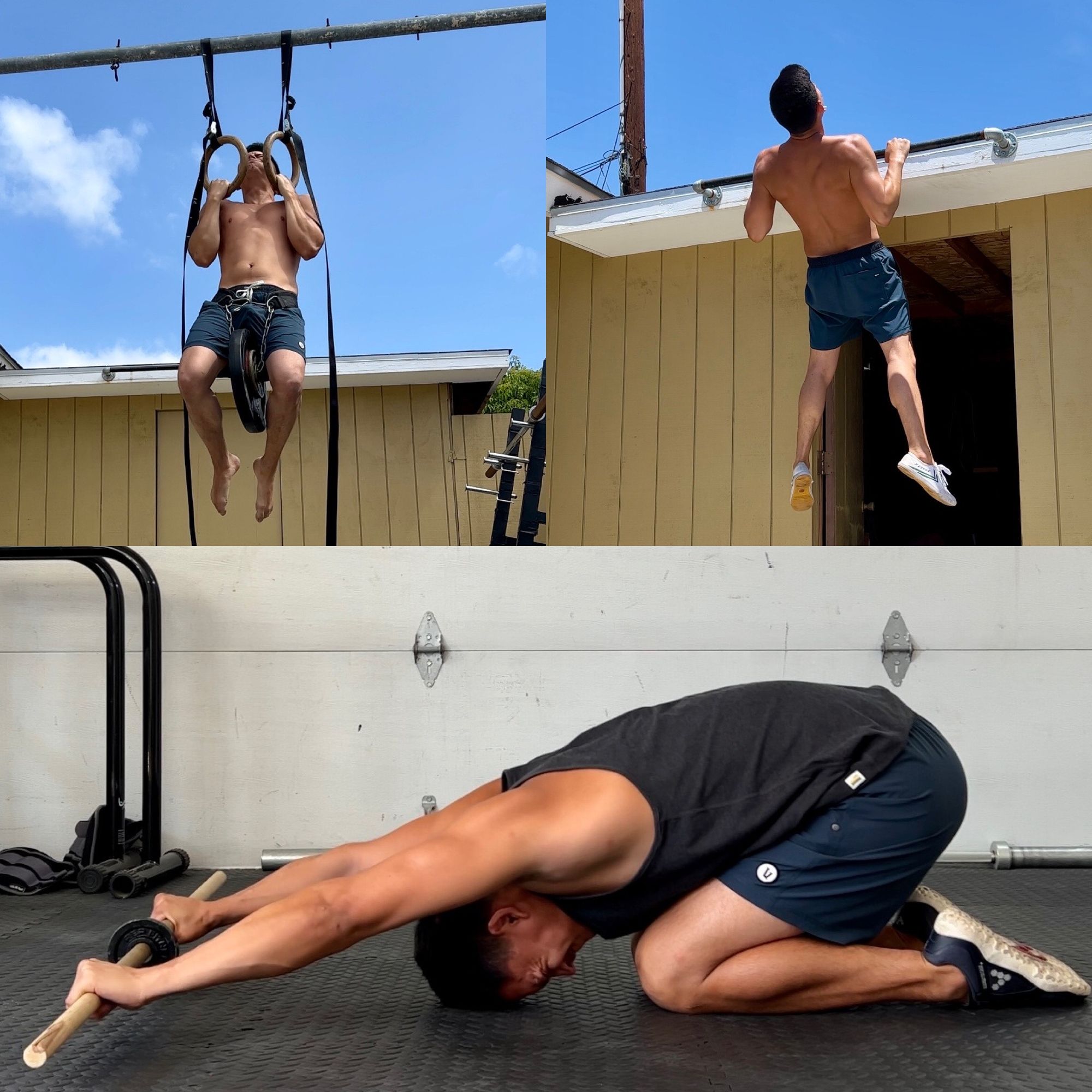
Lower Body Example
Now let's repeat the process for someone with the goal of increasing deadlift strength and improving tightness in the groin. A common lower body strength session without flexibility work for this individual may look like this:
A Deadlift
B1 Split Squat
B2 Nordic Curl
C1 Calf Raises
C2 Hanging Leg Raises
Since they are looking to improve their groin tightness, a great bang for your buck exercise is the tailors pose as shown in the bottom right corner of the next collage. This exercise can pretty much be swapped out with any exercise from B1-C2 and it all depends on the individuals' strengths, weaknesses, and interests. For the sake of providing an example, let's say the individual also wants to improve their Nordic curl but is also blessed with beefy calves. A great place for the tailors pose would be in C1.
Over the course of 6-8 weeks, strength can very well be gained on the deadlift and the groin tightness tackled. No need to add the stretches at the end of the session or dedicate huge amounts of time towards it.
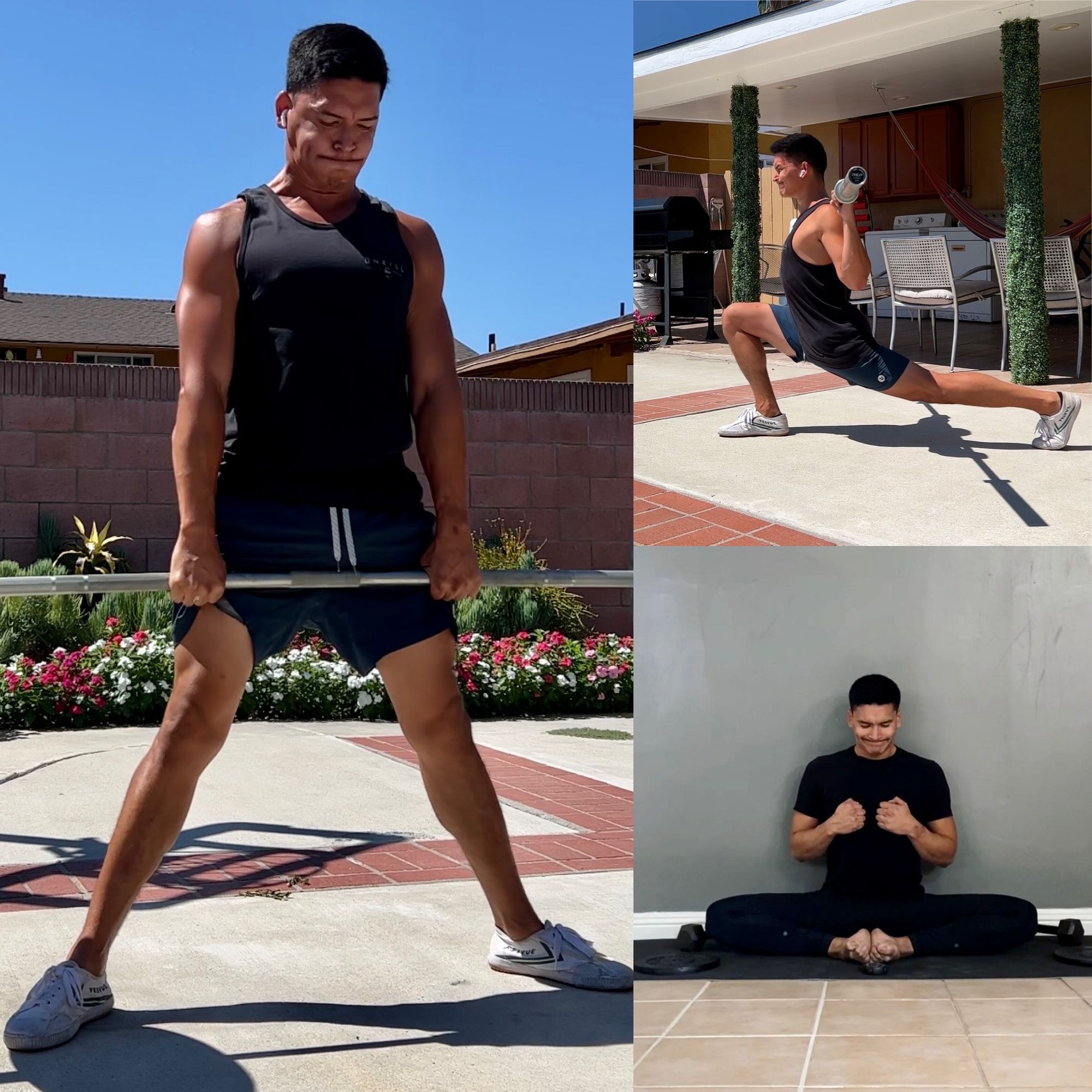
What to Look Out For
The main thing to look out for when making changes to a training program is recovery. While we want to improve our strength and flexibility, we don't want to injure ourselves. My recommendation here is to take it very easy at the start, there's no reason to race to a less stiff chest or a more flexible ankle. Intensity can always be increased over time.
My tip here is to make the changes to your program that you see fit and perform the workout. If you're sore for much longer than you expected in the days after the workout, 4-5+ days, then it may be that the workout was too demanding and intense for your body. In this case, the intensity should be reduced in the following session and the monitoring of our recovery continues.
If the soreness only lasts for a few days, then the modified program is potentially a good fit and the intensity only needs to be decreased ever so slightly and progressed over time.
Conclusion
Overall, we learned how strength training and flexibility training can be looked at as one in the same due to the fact that they can both be trained and progressed by using the same techniques. The simplest way to introduce flexibility exercises into a strength session is to swap out assistance exercises or remedial exercises based on the individuals' goals and physiology. And the primary thing to look out for when making changes to a plan is fatigue as too much fatigue may result in an injury.
Disclaimer
This article isn't meant for high-level athletes with very specific goals and highly tailored programs. This information is intended for the everyday human who already spends time in the weight room and is also looking to make some improvements in their flexibility. At the end of the day, not working on your flexibility will never make you more flexible. But including a small amount of flexibility work into your strength training and doing it with a genuine intent will absolutely improve your flexibility and general well-being over time. And that's the intention of this article.
If you enjoyed this article, I encourage you to subscribe to my weekly newsletter, The Sunday Spread, where I share more training tips, discounts on my coaching services and products, as well as my personal interests like podcasts and book reviews. You can sign up by hitting the gray button in the bottom right-hand corner and dropping your email! I can also be reached through the contact form found here. Hope to chat soon!


